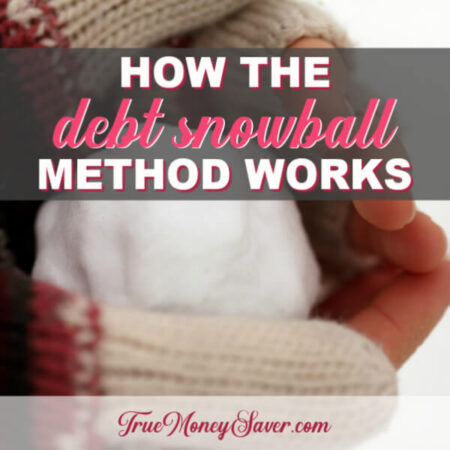 You can easily payoff debt with this easy method called the Snowball Method.
You can easily payoff debt with this easy method called the Snowball Method.
Imagine a tiny snowball in your hand.
Now imagine that same snowball rolling down a big hill going at high speed.
While that little snowball used to fit in the palm of your hand, now it’s growing bigger and bigger as it works its way down the hill.
The tiny snowball gains momentum and finally when it reaches the bottom, it’s tripled or more in size!
The debt snowball method works in precisely the same way!
It is a great way to payoff debt aggressively, and eliminate it once and for all!

How It Works
This method to payoff debt is based on the premise of paying your debts by size from smallest balance to largest balance and gaining more momentum as each debt balance is paid off to make paying off debt happen even faster.
Once you have paid off your smallest debt, you use the money you were putting toward that debt and put it toward your next lowest balance.

Here Is An Example Of The Snowball Method In Action!
Meet Traci, she recently graduated from college with a degree in English, ready to take on the job market, and start her new life. Traci was fortunate enough to have some help getting through college, but she still had a $10,000 student loan.
After graduation, Traci felt that she had earned the right to upgrade her old rusty car, so she went to a car dealership and took out a $3,000 car loan to pay for her new ride. She justified this purchase by telling herself that she bought used, therefore saving her money.
BONUS DOWNLOAD

Feel Less Stress While Paying Off Debt
Download this FREE Guide to have more peace & less stress while getting out of debt.
Fast forward a few months and Traci has yet to land a job. She has been paying her bills, rent, and nights out on the town with her credit card and has accumulated $5,000 in debt so far.
Feeling disappointed and discouraged from not finding a job, she decides to take a vacation with her friends to Europe. She charges the trip to her credit card adding $3,000 to her credit card debt.
After her “much needed” time away from her worries at home, she is ready to get back to the job hunt. She finally lands a job working in a big corporate office, and starts on Monday! This job requires a business professional dress, so Traci decides to take her credit card on a shopping spree for work clothes and racks up another $800 in debt.
When her first paycheck arrives, she’s so excited to spend her hard earned money, until she goes to check the mail. She has not only maxed out her credit cards, but her minimum payments ALONE are more than she can afford.
Traci realizes that she is in over her head, but ready to payoff debt. Her debt breakdown looks like this:
$1,000 medical bill ($50 payment)
$3,000 car loan ($100 payment)
$8,800 credit card debt ($200 payment)
$10,000 student loan ($95 payment)
Let’s say Traci takes on a part-time job to help pay down her debt. She will receive roughly $500 a month from this part-time job. She would have enough to pay for this medical bill in just two months!
If Traci were to use the debt snowball method on her debt, she would make minimum payments on everything except for the next lowest debt balance. After that initial debt of the medical bill is paid in full, she would then take that $550 (the $500 from the part-time job and the $50 minimum payment towards the medical bill), and put it toward her car loan.
Then, once the car loan debt is paid off, she would now have $650 each month to put towards her Credit Card, the next lowest balance.
By the time she’s ready to tackle her student loan, she will be able to put $850 towards her debt each month!

Why Does The Debt Snowball Method Work?
After hearing Traci’s story, you might be thinking that you were in a very similar situation to her. In our example with Traci, if she had started with her credit card debt, she would be paying that debt for years! She would never get the rewarding satisfactory feeling of paying something off, and it would take longer to absorb that extra payment to use towards the other debt.
If you start by getting rid of your smallest amount of debt first, you will start to see real and tangible progress. The debt you paid off will be gone from your life forever, and the next, and the next, and so on.
When you see progress, you will be more likely to stick to your plan and become debt-free.
The truth is that the debt snowball is not about math, but changing your behaviors and mindset!
Your Turn: Are you excited to pay off debt? Comment below with any questions about this process!

More Fun Articles To Read:




